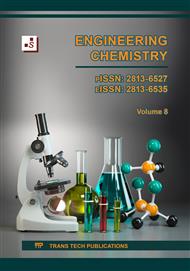[1]
Carpenter, A., Oil pollution in the North Sea: the impact of governance measures on oil pollution over several decades. Hydrobiologia 845, 109-127, (2019).
DOI: 10.1007/s10750-018-3559-2
Google Scholar
[2]
Bai, Y.R., Dai, L.Y., Sun, J.S., Jiang, G.C., Lv, K.H., R.C., Cheng, Shang, X.S., Plugging performance and mechanism of an oil-absorbing gel for lost circulation control while drilling in fractured formations. Petroleum Science 19, 2941-2958, (2022).
DOI: 10.1016/j.petsci.2022.08.004
Google Scholar
[3]
Haryanto, B., Nasution, I.T., Polem, A.F., Tambun, R., Alexander, V., Natural adsorbent of corncob (Zea mays L.) powder capability in purification of used cooking oil with shaking operation based on turbidity. Results in Engineering 19, 101233, (2023).
DOI: 10.1016/j.rineng.2023.101233
Google Scholar
[4]
Liu, T., A natural armor-protected absorbent from discarded durian peel with rapid and recyclable absorption, high oil retention and self-cleaning ability. Colloids and Surfaces A: Physicochemical and Engineering Aspects 666, 131294, (2023).
DOI: 10.1016/j.colsurfa.2023.131294
Google Scholar
[5]
Lipika, Singh, A.K., Fluorine-free surface coating to prepare hydrophobic and magnetic sawdust particles for oil spill absorption. Bioresource Technology Reports 25, 101758, (2024).
DOI: 10.1016/j.biteb.2023.101758
Google Scholar
[6]
Sun, J., Li, R., Wang, X.Y., Zhao, C.H., Song, Q.W., Liu, F., Wang, Z.H., Liu, C.S., Zhang, X.X., Marine oil spill remediation by Candelilla wax modified coal fly ash cenospheres. Chemosphere 330, 138619, (2023).
DOI: 10.1016/j.chemosphere.2023.138619
Google Scholar
[7]
Kyaw, H.H., Myint, M.T.Z., Al-Belushi, M.A., Dobretsov, S., Al-Abri, M., Nanomaterial grafted polymorphous activated carbon cloth surface for antibacterial, capacitive deionization and oil spill cleaning applications. Chemosphere 350, 141053, (2024).
DOI: 10.1016/j.chemosphere.2023.141053
Google Scholar
[8]
Yang, R., Cao, Q.H., Liang, Y.Y., Hong, S., Xia, C.L., Wu, Y.J., Li, J.Z., Cai, L.P., Sonne, C., Le, Q.V., Lam, S.S., High capacity oil absorbent wood prepared through eco-friendly deep eutectic solvent delignification. Chemical Engineering Journal 401, 126150, (2020).
DOI: 10.1016/j.cej.2020.126150
Google Scholar
[9]
Zhang, Y.R., Wang, Y.X., Construction of three-dimensional aerogels from electrospun cellulose fibers as highly efficient and reusable oil absorbents. Separation and Purification Technology 353, 128604, (2025).
DOI: 10.1016/j.seppur.2024.128604
Google Scholar
[10]
Wu, D., Wang, T.S., Hu, S.Y., Wu, W.B., Lu, B.B., Huang, X.Y., Yu, W., Wang, M., Wang, G.G., Zhang, J.H., Solvent-free processing of eco-friendly magnetic and superhydrophobic absorbent from all-plant-based materials for efficient oil and organic solvent sorption. Science of the Total Environment 800, 149558, (2021).
DOI: 10.1016/j.scitotenv.2021.149558
Google Scholar
[11]
Bannov, A.G., Timofeeva, A.A., Shinkarev, V.V., Dyukova, K.D., Ukhina, A.V., Maksimovskii, E.A., Yusin, S.I., Protection of Metals and Physical Chemistry of Surfaces 50(2), 183-190, (2014).
DOI: 10.1134/s207020511402004x
Google Scholar
[12]
Yang, H.W., Bian, S., Hu, J.Q., Li, F.B., Yao, T., Effect of water chemistry on the adsorption of lubricating oil on oxidized graphite. Journal of Molecular Liquids 219, 1157-1160, (2016).
DOI: 10.1016/j.molliq.2016.04.016
Google Scholar
[13]
Ding, X.H., Wang, R., Zhang, X., Zhang, Y.Z., Deng, S.H., Shen, F., Zhang, X.H., Xiao, H., Wang, L.L., A new magnetic expanded graphite for removal of oil leakage. Marine Pollution Bulletin 81, 185-190, (2014).
DOI: 10.1016/j.marpolbul.2014.01.056
Google Scholar
[14]
Tian, Y.Y., Ma, H.Z., Solvent-free green preparation of reusable EG-PVDF foam for efficient oil water separation. Separation and Purification Technology 253, 117506, (2020)
DOI: 10.1016/j.seppur.2020.117506
Google Scholar
[15]
Yao, T., Zhang, Y.G., Xiao, Y.P., Zhao, P.C., Guo, L., Yang, H.W., Li, F.B., The effect of environmental factors on the adsorption of lubricating oil onto expanded graphite. Journal of Molecular Liquids 218, 611-614 , (2016).
DOI: 10.1016/j.molliq.2016.02.050
Google Scholar
[16]
Takeuchi, K., Fujishige, M., Kitazawa, H., Akuzawa, N., Medina, J.O., Morelos-Gomez, A., Cruz-Silva, R., Araki, T., Hayashi, T., Terrones, M., Endo, M., Oil sorption by exfoliated graphite from dilute oil-water emulsion for practical applications in produced water treatments. Journal of Water Process Engineering 8, 91-98, (2015).
DOI: 10.1016/j.jwpe.2015.09.002
Google Scholar
[17]
X u, C.B., Jiao, C.L., Yao, R.H., Lin, A.J., Jiao, W.T., Adsorption and regeneration of expanded graphite modified by CTAB-KBr/H3PO4 for marine oil pollution. Environmental Pollution 233, 194-200, (2018).
DOI: 10.1016/j.envpol.2017.10.026
Google Scholar
[18]
Wei, Q., Xu, L., Tang, Z.M., Xu, Z.B., Xie, C., Guo, L.R., Li, W., High-performance expanded graphite from flake graphite by microwave-assisted chemical intercalation process. Journal of Industrial and Engineering Chemistry 122, 562-572, (2023).
DOI: 10.1016/j.jiec.2023.03.020
Google Scholar


